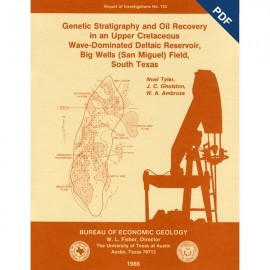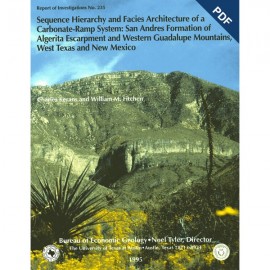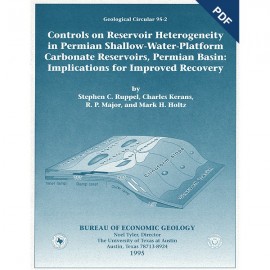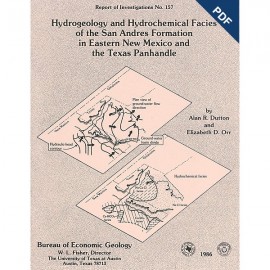Reports of Investigations
-
Books & Reports
- Reports of Investigations
- Guidebooks
- Udden Series
- Geological Circulars
- Down To Earth
- Atlases of Major Oil and Gas Reservoirs
- Texas Memorial Museum Publications
- Environmental Geologic Atlas of the Texas Coastal Zone
- Mineral Resource Circulars
- Other Reports
- Seminars and Workshops
- Handbooks
- Submerged Lands of Texas
- Symposia
- Annual Reports
- Open File Reports
-
Maps & Cross Sections
- Thematic Maps
- Miscellaneous Maps, Charts & Sections
- Geologic Atlas of Texas
- STATEMAP Project Maps
- Geologic Quadrangle Maps
- Cross Sections
- Highway Geology Map
- Energy and Mineral Resource Maps
- Shoreline Change and Other Posters
- Wilcox Group, East Texas, Geological / Hydrological Folios
- Bouguer Gravity Atlas of Texas
- River Basin Regional Studies
- Featured Maps
- Posters
- Teachers & the Public
-
Geological Society Publications
- Gulf Coast Association of Geological Societies
- Alabama Geological Society
- Austin Geological Society
- Corpus Christi Geological Society
- Houston Geological Society
- Lafayette Geological Society
- Mississippi Geological Society
- New Orleans Geological Society
- South Texas Geological Society
- GCS SEPM Publications
- Historic BEG & UT Series
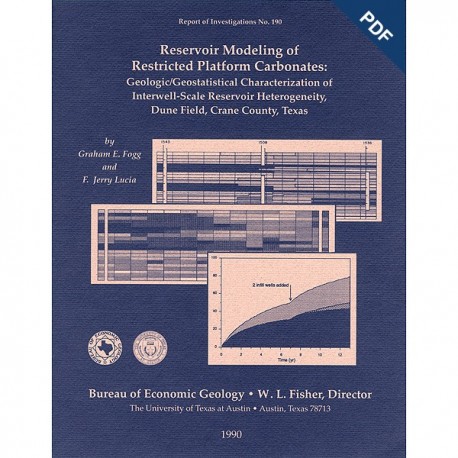
Reservoir Modeling of Restricted Platform Carbonates:...Dune Field, Crane County, Texas. Digital Download
RI0190D
For a print version: RI0190.
RI0190D. Reservoir Modeling of Restricted Platform Carbonates: Geologic/Geostatistical Characterization of Interwell-Scale Reservoir Heterogeneity, Dune Field, Crane County, Texas, by G. E. Fogg and F. J. Lucia. 66 p., 58 figs., 4 tables, 2 appendices, 1990. doi.org/10.23867D/RI0190D. Downloadable PDF.
To purchase this publication in book format, please order RI0190.
ABSTRACT
Petroleum reservoirs typically yield only a fraction of the oil initially in place because geologic heterogeneity causes incomplete drainage of oil. Accurately predicting oil recovery requires realistic estimates of interwell porosity and permeability patterns that are discontinuous in both the horizontal and the vertical direction. Results of this study, which show the effects of heterogeneity on fluid flow and oil recovery efficiency through several simulation experiments, are applicable to many other carbonate and noncarbonate fields worldwide. The experiments were conducted using cross sections of a lower portion of the Grayburg reservoir in Section 15 of the Dune field. A technique combining petrophysics and geophysical borehole logs was used to estimate permeabilities at 1-ft intervals in wells spaced approximately 930 ft apart (20-acre spacing). Detailed interwell permeability patterns were estimated by both deterministic and stochastic geologic interpretation. Deterministic interpretation involved correlating permeabilities between wells and, owing to lack of a better geological model, assuming gradational changes in permeability where lateral discontinuities occurred. Stochastic geologic interpretations generated with a geostatistical method known as conditional simulation accounted for interwell uncertainty and provided the more complex, realistic permeability distributions that are needed to predict performance of infill wells.
Simulation of waterflooding in the deterministic permeability distributions illustrated key mechanisms causing bypass of mobile oil. High-permeability strata desaturated rapidly and became thief zones, or conduits for rapid cycling of water from injector to producer, resulting in poor sweep efficiency. Despite horizontal stratification of high- and low-permeability facies, vertical flow in the simulations was significant, sometimes making isolation of thief zones by selective perforation difficult. Simulation of waterflooding in stochastically generated permeability distributions indicated that no more than 40 to 55 percent of the mobile original oil in place (MOOIP) could be produced with the existing well spacing (10 acres). Adding infill wells to achieve an average well spacing of 2.5 acres generally increased the recovery efficiency of MOOIP by at least 27 to 32 percentage points. The infill wells tended to cause high water/oil ratios where the well spacing was less than 2.5 acres or where the high-permeability facies were laterally extensive relative to well spacing. In general, the stochastic permeability distributions giving the most realistic water/oil ratios (WOR) in the simulator before infill also yielded low to moderate WOR's after infill.
Keywords: Dune field, geostatistics, Grayburg, permeability, Permian Basin, petroleum recovery efficiency, reservoir characterization, simulation, stochastic, Texas
CONTENTS
Abstract
Introduction
Dune Field Background and Reservoir Geology
Methods
Estimating Absolute Permeability
Geostatistics
Variography
Conditional simulations
Simulation of Two-Phase Fluid Flow
Deterministic Modeling of Heterogeneity and Its Effects on Two-Phase Flow
Permeability Cross Sections
Simulator Construction
Simulation Results and Discussion
Model D/55-56
Model 0143-36
Stochastic Modeling of Heterogeneity and Its Effects on Infill Drilling Performance
Variogram Analysis (Variography)
Vertical variography
Horizontal variography
Choosing horizontal variogram models
Conditional Simulation
General appearance of simulated fields
Choosing realizations for simulation of flow
Simulation of Waterflooding and Infill Drilling
Results
Model D/155-56
Model S/43-36
Effects of relative permeability on flow in cross section 43-36
Discussion
Effects of Neglecting the Third Dimension
Implications for Infill Drilling
Transferability of the Results
Other Methods of Estimating Recoverable Oil
Summary and Conclusions
Acknowledgments
References
Appendix A: Permeability Cross Sections in Southeast Quadrant of Section 15
Appendix B: Conditionally Simulated Permeability Fields
English to Metric Conversions
Figures
- Location of study area
- Schematic diagram showing styles of megascopic and macroscopic heterogeneity common to San Andres and Grayburg reservoirs
- Map of Mobil University Unit 15/16 and surrounding area in the Dune field, University Block 30, Crane County, Texas
- Lithofacies dip section across the Dune field
- Porosity-permeability cross plot for various particle-size groups in nonvuggy carbonate rocks
- Photomicrographs showing (a) interparticle porosity, (b) intercrystalline porosity, (c) mixed (interparticle and intercrystalline) porosity in the Dune field
- Depth plot, Mobil University well 1535, comparing core permeability with permeability calculated from petrographic data and wireline logs
- Depth plot, Mobil University well 1560, comparing core permeability with permeability calculated from petrographic data and wireline logs
- Schematic example showing how the experimental variogram can be calculated in one dimension
- Concept of conditional simulation illustrated in one dimension
- Map showing contours on kh for the MA zone
- Permeability cross section B-B' oriented parallel to the high-permeability grainstone bar
- Permeability cross section C-C' oriented perpendicular to the high-permeability grainstone bar
- Permeability cross section between Mobil University wells 1555 and 1556 using superimposed finite-difference grid in the deterministic simulations
- Permeability cross section between Mobil University wells 1543 and 1536 using superimposed finite-difference grid in the deterministic simulations
- Relative permeability curves used in the flow simulations, sets 1 and 2
- Oil saturations computed by the D/55-56 model
- Oil production rate versus time, D/55-56 model
- Producing water/oil ratio versus time, D/55-56 model
- Measured oil production rate versus time, Mobil University wells 1555 and 1556
- Measured water/oil ratio versus time, Mobil University wells 1555 and 1556
- Oil saturations computed by the D/43-36 model
- Oil production rate versus time, D/43-36 model
- Producing water/oil ratio versus time, D/43-36 model
- Vertical experimental variograms (y,*) showing vertical correlation of permeability in grainstone- and nongrainstone-dominated facies of the MA zone
- Permeability profile, well 1556
- Vertical experimental variogram (Y,* ) showing vertical correlation of permeability in the MA zone of Mobil University wells 1555 and 1556
- Vertical experimental variogram (Y;) showing vertical correlation of permeability in the MA zone of Mobil University wells 1543 and 1536
- Horizontal experimental variograms (Y;) showing directional correlation of permeability in the horizontal plane, MA zone, Section 15
- Sketch showing horizontal and vertical search regions used for computing horizontal experimental variograms (Y, ) from permeability data
- Horizontal variogram models (T used to generate stochastic simulations of permeability between wells 1555 and 1556
- Horizontal variogram models 0 used to generate stochastic simulations of permeability between wells 1543 and 1536
- Spatial distributions of permeability in the two stochastic realizations chosen from case S/55-56-A
- Spatial distributions of permeability in the two stochastic realizations chosen from case S/55-56-B
- Spatial distributions of permeability in the two stochastic realizations chosen from case S/43-36-A
- Spatial distributions of permeability in the two stochastic realizations chosen from case S/43-36-B
- Sketch defining horizontal and vertical continuity (Ch and C>) of interconnected domains consisting of permeabilities above a cutoff value
- Simulated oil saturations based on permeabilities from realization A154, cross section 55-56
- Simulated oil saturations based on permeabilities from realization B10, cross section 55-56
- Oil production rates versus time computed for cross section 55-56 in waterflood simulations
- Cumulative oil production versus time computed for cross section 55-56 in waterflood simulations
- Producing water/oil ratios versus time computed for cross section 55-56 in waterflood simulations
- Recovery efficiency versus well spacing in acres Oil production rates versus time computed for cross section 43-36 in waterflood simulations
- Cumulative oil production versus time computed for cross section 43-36 in waterflood simulations
- Producing water/oil ratios versus time computed for cross section 43-36 in waterflood simulations
- Oil production rates versus time computed for cross section 43-36 with alternate relative permeability curves
- Cumulative oil production versus time computed for cross section 43-36 with alternate relative permeability curves
- Producing water/oil ratios versus time computed for cross section 43-36 with alternate relative permeability curves
- Producing water/oil ratios versus time computed for cross section 43-36 with alternate relative permeability curves
- (a) Fluid flow streamlines in the horizontal plane between a producer and an injector; (b) Breakthrough of an oil bank caused by flow along each streamline
Tables
1. List of flow simulations performed
2. Statistics from stochastic simulations and continuity of simulated facies having k 2100 md
3. Waterflood simulation results of model S/55-56
4. Waterflood simulation results of model S/43-36
Appendix Figures
A.1. Permeability cross section 43-36
A.2. Permeability cross section 45-52
A.3. Permeability cross section 39-54
A.4. Permeability cross section 55-56
B.1. Kriged and simulated permeability for case 55-56-A
B.2. Kriged and simulated permeability for case 55-56-B
B.3. Kriged and simulated permeability for case 43-36-A
B.4. Kriged and simulated permeability for case 43-36-B
Citation
Fogg, G. E., and Lucia, F. J., 1990, Reservoir Modeling of Restricted Platform Carbonates: Geologic/Geostatistical Characterization of Interwell-Scale Reservoir Heterogeneity, Dune Field, Crane County, Texas: The University of Texas at Austin, Bureau of Economic Geology, Report of Investigations No. 190, 58 p.

